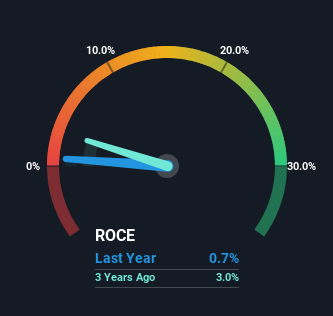- United States
- /
- Electrical
- /
- NasdaqCM:APWC
Asia Pacific Wire & Cable (NASDAQ:APWC) Could Be At Risk Of Shrinking As A Company

What financial metrics can indicate to us that a company is maturing or even in decline? Businesses in decline often have two underlying trends, firstly, a declining return on capital employed (ROCE) and a declining base of capital employed. This indicates the company is producing less profit from its investments and its total assets are decreasing. So after glancing at the trends within Asia Pacific Wire & Cable (NASDAQ:APWC), we weren't too hopeful.
Return On Capital Employed (ROCE): What Is It?
Just to clarify if you're unsure, ROCE is a metric for evaluating how much pre-tax income (in percentage terms) a company earns on the capital invested in its business. To calculate this metric for Asia Pacific Wire & Cable, this is the formula:
Return on Capital Employed = Earnings Before Interest and Tax (EBIT) ÷ (Total Assets - Current Liabilities)
0.0067 = US$1.5m ÷ (US$367m - US$141m) (Based on the trailing twelve months to December 2023).
Thus, Asia Pacific Wire & Cable has an ROCE of 0.7%. Ultimately, that's a low return and it under-performs the Electrical industry average of 13%.
See our latest analysis for Asia Pacific Wire & Cable

Historical performance is a great place to start when researching a stock so above you can see the gauge for Asia Pacific Wire & Cable's ROCE against it's prior returns. If you'd like to look at how Asia Pacific Wire & Cable has performed in the past in other metrics, you can view this free graph of Asia Pacific Wire & Cable's past earnings, revenue and cash flow.
The Trend Of ROCE
There is reason to be cautious about Asia Pacific Wire & Cable, given the returns are trending downwards. To be more specific, the ROCE was 3.7% five years ago, but since then it has dropped noticeably. And on the capital employed front, the business is utilizing roughly the same amount of capital as it was back then. This combination can be indicative of a mature business that still has areas to deploy capital, but the returns received aren't as high due potentially to new competition or smaller margins. If these trends continue, we wouldn't expect Asia Pacific Wire & Cable to turn into a multi-bagger.
On a side note, Asia Pacific Wire & Cable's current liabilities have increased over the last five years to 38% of total assets, effectively distorting the ROCE to some degree. If current liabilities hadn't increased as much as they did, the ROCE could actually be even lower. While the ratio isn't currently too high, it's worth keeping an eye on this because if it gets particularly high, the business could then face some new elements of risk.
The Bottom Line
In summary, it's unfortunate that Asia Pacific Wire & Cable is generating lower returns from the same amount of capital. Long term shareholders who've owned the stock over the last five years have experienced a 27% depreciation in their investment, so it appears the market might not like these trends either. With underlying trends that aren't great in these areas, we'd consider looking elsewhere.
If you want to continue researching Asia Pacific Wire & Cable, you might be interested to know about the 1 warning sign that our analysis has discovered.
While Asia Pacific Wire & Cable isn't earning the highest return, check out this free list of companies that are earning high returns on equity with solid balance sheets.
New: Manage All Your Stock Portfolios in One Place
We've created the ultimate portfolio companion for stock investors, and it's free.
• Connect an unlimited number of Portfolios and see your total in one currency
• Be alerted to new Warning Signs or Risks via email or mobile
• Track the Fair Value of your stocks
Have feedback on this article? Concerned about the content? Get in touch with us directly. Alternatively, email editorial-team (at) simplywallst.com.
This article by Simply Wall St is general in nature. We provide commentary based on historical data and analyst forecasts only using an unbiased methodology and our articles are not intended to be financial advice. It does not constitute a recommendation to buy or sell any stock, and does not take account of your objectives, or your financial situation. We aim to bring you long-term focused analysis driven by fundamental data. Note that our analysis may not factor in the latest price-sensitive company announcements or qualitative material. Simply Wall St has no position in any stocks mentioned.
Have feedback on this article? Concerned about the content? Get in touch with us directly. Alternatively, email editorial-team@simplywallst.com
About NasdaqCM:APWC
Asia Pacific Wire & Cable
Through its subsidiaries, manufactures and distributes enameled wire, power cable, and telecommunications products in Thailand, North Asia, and internationally.
Adequate balance sheet and slightly overvalued.
Market Insights
Community Narratives



